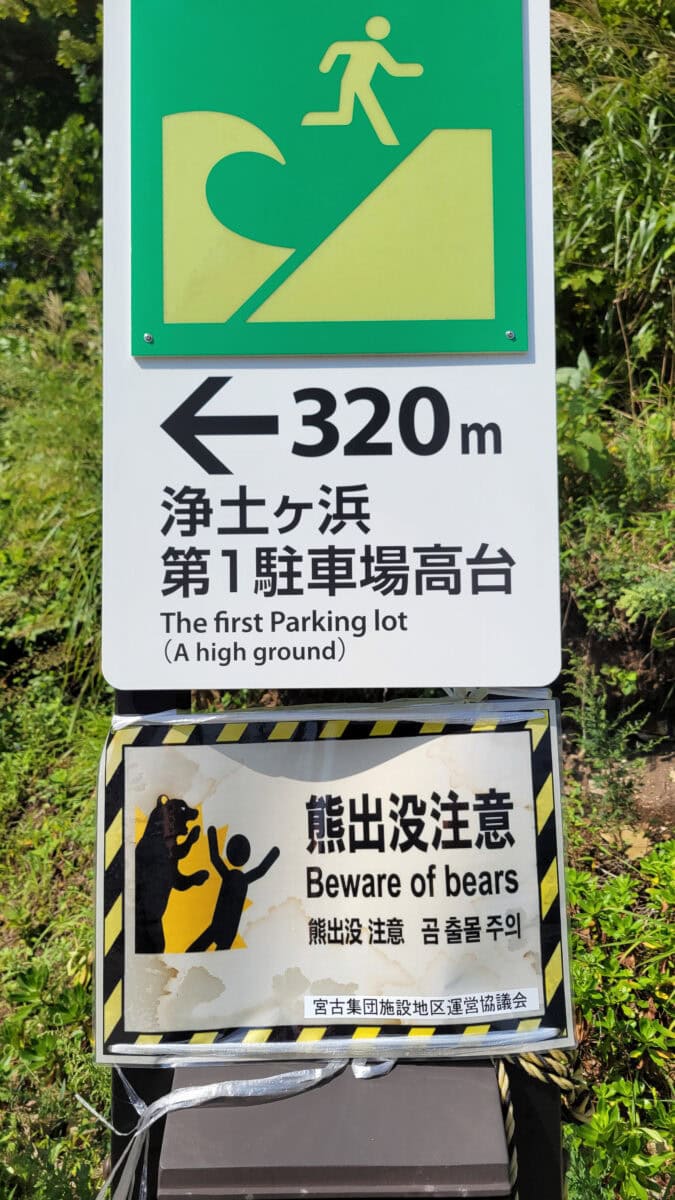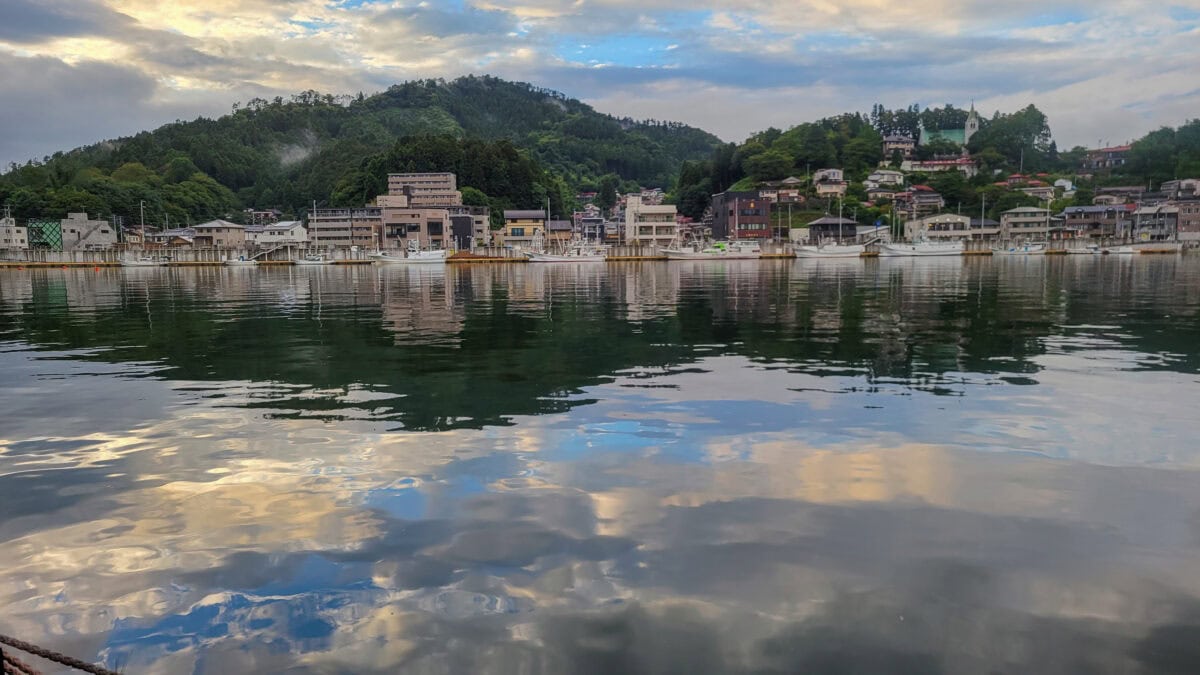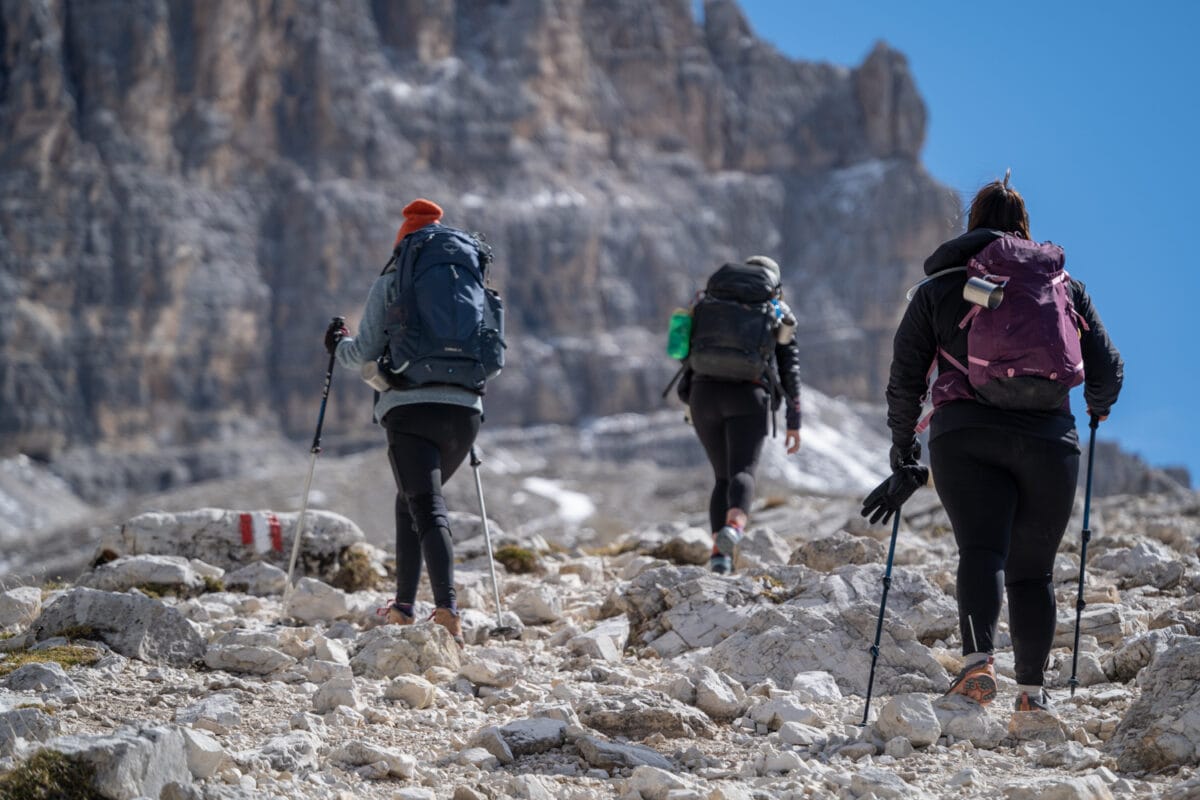This article may contain affiliate links where I make a small commission for purchases you make from links that you click from this article. By purchasing through these links, you support me at no additional cost to you. Thanks for your support.
On a recent trip to Japan, a local told me, “Tokyo is not Japan…to know Japan you have to go out and explore.” And if you’ve followed this blog for a while, you know that getting off the beaten track and exploring a hidden region puts me in my happy place. It’s my favorite way to travel. When I heard about Japan’s Tohoku region and the new Michinoku Coastal Trail– I was intrigued because I love discovering new long-distance hikes. Suddenly, this little-known region in Japan was on my radar.
My journey to Tohoku was initially about hiking a portion of the Michinoku Coastal Trail. However, I soon discovered that Tohoku’s rugged coast offered much more than a hiking adventure. It was a land of resilient people, incredible seafood, and unique cultural experiences that I had never encountered before. The region’s intimate feel and the warmth of its people made it a truly unique destination.
Japan’s Most Beautiful Coastline That You’ve Never Heard Of
Paradise found is also paradise lost in tourism. Overtourism can happen quickly, and it reaches a tipping point, and suddenly, you have too many people all going to the same places. Ensuring balance is key. That’s why Japanese tourism hopes to create more balance by building up tourism offerings in lesser-visited regions like Tohoku. This is one of the reasons they created the Michinoku Coastal Trail, which initially drew me there. I guess that means it’s working.
Tohoku, a region known among the Japanese but often overlooked by international travelers, is a hidden gem waiting to be discovered. With its stunning Rias Coast, the only rugged coastline in Japan, it offers the most beautiful coastline in the country, as recognized by Japan’s Tourism Board. This unique beauty is a testament to the region’s allure.
While Tokyo and Kyoto may be the go-to spots for many visitors, Tohoku is a treasure trove waiting to be explored by those who seek adventure and natural beauty.
Tohoku Map

Since this article focuses on travel to the Tohoku East Coast, I am focusing on the Miyagi, Iwate, and Aomori Prefectures. The coastal towns in these prefectures were reachable by local trains and buses. This coastline is known as the Sanriku Coast – a dramatic, rocky shoreline with countless bays, cliffs and coves that stretches for over 300 kilometers along the Pacific Coast of the Tohoku Region.
What Makes Tohoku Travel Unique
Tohoku’s rugged coastline and low number of tourists are two of the things that make traveling there so great. The third item, though, is a bit unique. Domestic and international visitors go there because the region suffered one of Japan’s most significant natural disasters.
The March 11, 2011, Great East Japan Earthquake and the ensuing tsunami left a profound mark on the tranquil Tohoku region. Towering waves—some as high as 130 feet—surged up to six miles inland, claiming approximately 20,000 lives and devastating communities. The aftermath of this tragedy required years of effort to clear the rubble and begin healing.

Rebuilding Tohoku After the Tsunami

Over a decade later, they rebuilt (sometimes relocating) the towns, created new warning systems and built more enormous tsunami walls. The Michinoku Coastal Trail (MCT) is one of the latest sites/experiences they made to help the region rebuild emotionally, bring tourism back to the region, and, in turn, add to the economy of a distressed area. A 1,000 km hiking trail means revitalization of the entire coastline, new hotels, restaurants, tourism experiences, and a rebuilt rail line to move people along the coast.
I was surprised to learn that even the visiting Japanese tourists are interested in learning how the Tohoku region has been rebuilt. They hire tour guides to walk them through sections of the trail along the Rias Coast and teach them about the tsunami. They use it as a learning experience so that the younger generation knows what they should and shouldn’t do during a disaster.
As I hiked along the MCT I heard stories of adults and children alike who perished because they were following incorrect instructions from others – even though they likely knew better and could have saved themselves. This was hard to hear – but also not surprising.
Japan is considered a collective society. They value group harmony, shared responsibilities, and prioritizing the well-being of the community over individual desires. There is a hesitation to act independently. This value is deeply embedded in Japanese society, influencing behavior, decision-making, and responses to crises. In this case, it cost people their lives.
Tendenko – A New Cultural Philosophy
The region is now being taught Tendenko. Tendenko is a Japanese concept that emphasizes individual survival during disasters. It teaches that in moments of crisis, people should focus on saving themselves without worrying about others, trusting that everyone will do the same. This concept has gained prominence in the region’s post-disaster culture, influencing behavior and responses to crises. It’s hard to change a culture, but everywhere I went along the coast, I heard about Tendenko. It’s taught in schools and talked about in homes, and you’ll also learn about it if you visit the region.
Tohoku Tsunami Memorials
Multiple memorials commemorating the lives lost, the aftermath, and the rebuilding process are dotted along the coast. It brings the entire disaster and the impact on the communities to life. You’d be amiss if you visited the area and didn’t go to one of the multiple memorials to learn more and connect with this area more deeply. They are beautiful and moving.
I recommend the Iwate Tsunami Memorial Museum in Rikuzentakata City. The building and grounds are somber but beautiful, and the museum and staff were phenomenal. See a chronological exhibit of artifacts and photographs documenting the disaster, and hear guides talk about their personal experience on that fateful day. It also includes a large outdoor space where you can walk and ruminate on the power of nature. It is also the home to the Miracle Lone Pine Tree – an homage to the only surviving tree of the entire Takata Pine Forest. It serves as a symbol of hope for the entire region.
The region has also chosen to honor the memory of the day by leaving several buildings as they were – mangled, twisted, and in rubble. In addition, as you travel around the area, you’ll also see high water lines marked on buildings. These markings serve as a grim reminder of the disaster’s scale and the extreme water levels reached.
Finding a Travel Connection in Disaster
I know this may not seem like a typical place to travel to – but that’s why I loved it. In fact – I felt closer to the Tohoku region than any other in Japan as I traveled up the coast. I had heard about the tsunami in 2011. Still, I didn’t fully understand it until I saw and experienced the region myself. It was educational and moving, drawing me closer to Japan in general.
This is no different than other popular travel destinations -Hiroshima, Katrina Tours, the ruins of Pompeii, and Chernobyl. This is all considered Disaster tourism – a subsection of Dark tourism (Killing Fields in Cambodia, 9/11 Memorial and Museum, Brazil slum tourism, Auschwitz-Birkenau, etc) . If it’s not for you, I understand. I treat it as a way to learn more about the people and culture and take learnings from it that affect how I look at and connect with the world as a whole.
Tohoku Coast Experiences Not to Miss
Not everything in Tohoku is about the disaster – it’s just a small but meaningful part of the region. There are great traditional travel adventures and cultural experiences to be had along the coast! As I hiked some of the best parts of the Michinoku Coastal Trail, we also had a chance to experience other activities along the Tohoku coast.
Tohoku travel provides something for anyone who enjoys the outdoors
Jodogahama Kayaking
Jodogahama Beach is a must-stop on your Tohoku coastal travels. It is part of the Sanriku Fukko (reconstruction) National Park , which was created after the Great East Japan Earthquake and Tsunami as a way to help revitalize the region.
Stop at the Jodogahama visitor center, walk the pathways along the beach, and enjoy this scenic area. It is best known for its unusual white rock formations; jagged volcanic rocks jutting out of the turquoise waters. The white pebble beach is popular for locals to sunbathe and swim. I went kayaking so that I could get a closer look at the rock formations. You can easily rent kayaks and SUPs or even go on a coastal boat ride from the beach. And, of course – there’s plenty of hiking around the beach and visitor center. In fact, the MCT trail goes right along the beach!
Treat yourself and stay at the perfectly located, luxurious Jodogahama Park Hotel. Perched on top of the cliff above Miyako Bay, you can get an incredible view of the rocks and the beach below. The accommodations are traditional and sleek, the food is delicious, and the onsen is the cherry on top! This was my favorite hotel during my time on the Tohoku Coast!
Eat at L’Oreole Tanohata

Chef Katsuyasu Ito, a French-trained chef who went to culinary school in Tokyo, is bringing fine dining to the Tohoku Coast at L’Oreole Tanohata. Located right on the Michinoku Coastal Trail, the beautifully designed restaurant with all wood accents is perched on the coast, giving it incredible views and a rugged feel.
Watching Chef Ito create our multi-course lunch was like watching an artist at work. I love open kitchens and I had so much fun watching the cooking and plating of each intricate locally sourced dish. Chef Ito wants to educate visitors and locals about the abundance of incredible food that comes from this region. Everything he makes is locally sourced. He also works with the local school lunch program, educating kids on the region’s ingredients.
“If I want to be rich and make money, then I’d build a restaurant in one of the big cities. But that’s not the reason why I want to cook. I want to help the community and bring people here.”
Most of his guests come from out of town and stay to enjoy the rich bounty of the Tohoku Coast. One of the chef’s goals is to protect the smaller communities in Japan because, as he noted, everyone usually leaves and moves to big cities.
Like a “three-star restaurant” in a small European village, you can enjoy a meal that makes the most of local resources, including the view from the window!
Glamping on the Tanesashi Coast
Fall asleep under the stars and wake up to crashing waves. The Tanesashi Natural Lawn is a rare coastal grassland where lush green grass grows naturally right up to the edge of the Pacific Ocean. This blend of vibrant green fields and the deep blue sea creates a breathtaking, almost surreal landscape. The lawn is dotted with tents in the evenings as people are allowed to camp there.
You can experience camping among other outdoor enthusiasts while also enjoying a bit of pampering! Glamping experiences are also offered here, complete with a comfortable, warm cot and bedding and a chef who makes dinner and breakfast for you on the lawn!
Learn more about reserving your tent here.
Ebiking in Rikuzentakata City
This city was rebuilt after the tsunami and pushed back from the coast. However, they didn’t just push it back; they created it on higher ground. Essentially they created a disaster-resistant town by raising the height of the land they built on and moving the residences to higher ground. The city and region were one of the hardest hit along the coast.
Rent a bicycle or participate in a bike tour that can be arranged at the Rikuzentakata Bussan Center connected to the Iwate Tsunami Memorial Museum. It’s a great way to get around this bike-friendly region. The tour will take you around some of the tsunami destruction, but you’ll also cycle out into the countryside through quiet rice fields and out to the scenic coast.

Kessenuma Brewers Table Sake Tasting Dinner
Enjoy a unique pairing dinner where guests can learn about the sake, local seasonal foods, and seafood. Taste dishes made with seafood caught in Kesennuma. Each dish is accompanied by a selection of local sake from Otokoyama Honten, a local sake brewery, for a pairing unique to Kesennuma. You can decide to have the tasting dinner or dinner and an added tour of the sake brewery.

Tohoku Coast Tours
Suppose I have swayed you to consider visiting the Tohoku coast, and you are looking for someone to do all of the planning for you. In that case, you’ll want to check out some of these tours in the region.
Ottsworld Small Group Hiking Tour
I have put many of these experiences into my small group tour that takes you along the highlights of the Michinoku Coastal Trail. Meet locals, learn about the tsunami, and actively explore the beautiful Tohoku coastline.

Oku Japan Self-Guided Hiking Tour
This mainly covers the northern part of the Tohoku coast and sticks primarily to hiking the Michinoku Coastal Trail. However it includes many of the areas I covered above. They have curated the best parts of this trail, allowing you to walk through the most memorable areas before continuing onto the next section via train, bus, and taxi.
Oku 7 Day Self Guided Hiking Tour
Ottsworld Discount –get 5% off any Oku Japan tour with code OTTSWORLD5
Tohoku Emotion Train Tour
If hiking isn’t your jam, check out this daily train tour along the Sanriku Coast. TOHOKU EMOTION runs on the Hachinohe Line (Hachinohe Station to Kuji Station), which runs right along the coast. The train slows down at the most scenic spots so that passengers can fully appreciate the scenery. But best of all is, this is a foodie train. This restaurant train features an open kitchen where you can even watch the food being prepared. Enjoy a menu featuring local Tohoku foods while enjoying the coastal views.
Reserve a spot on Tohoku Emotion Train Tour

How to Get to Tohoku
The easiest way to get to various parts of Tohoku is by train. The Shinkansen (bullet train) is my recommended way of traveling from Tokyo. You can get a regional rail pass that offers unlimited travel in the Tohoku region on designated trains. The JR East Pass includes Tokyo, the Tohoku region, and surrounding areas.
The JR East Pass offers unlimited rides on JR buses and trains traveling on the JR lines Tohoku including the Tohoku Shinkansen.
Check out your options for the JR East Pass or Whole Japan passes if you plan to travel to other regions.

Sendai city in Miyagi prefecture is considered the major gateway to the Tohoku region. It offers easy connections to coastal towns via train or bus. It takes less than 2 hours to get from Tokyo to Sendai. Once you reach a major city like Sendai, you can use local trains or buses to access smaller coastal towns along the coastline
The Most Powerful Wave in Tohoku
One of the most impactful cultural experiences I experienced in Tohoku was the ‘Tokhoku wave.’ This wave has absolutely nothing to do with the tsunami; it is a simple wave goodbye. In Tohoku, it is a cultural certainty that the hotel staff will come outside and wave goodbye to you. Not only the hotels but the tour guides, visitor center employees, restaurant owners, and sometimes the chefs – everyone in the hospitality field will come out and bid you goodbye like I’ve never experienced before.
This gesture is filled with gratitude and warmth, often performed with such enthusiasm that it becomes a jubilant, two-handed motion. What stood out most was its remarkable persistence—it continues until you’re entirely out of view!
The Tohoku wave will most certainly draw you even closer to this region. The wave feels like a surge of joy carried through the air, embodying appreciation, a warm farewell, an invitation to return, and a deep respect for others. It’s an extended goodbye of tsunami proportions. You can’t help but feel the jubilance and gratitude they are giving you. You can’t help but want to come back and experience the Tohoku coast again.
There has never been a better time to plan your next trip and make your Dream vacation a reality . Whether you've been dreaming of relaxing on a sun-kissed beach, exploring ancient cities, or embarking on an epic adventure, now is the perfect moment to make it happen.


















